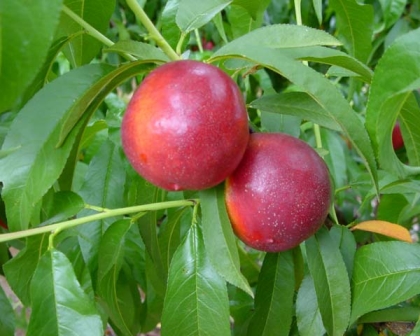COMPONENT COMPOSITION OF ESSENTIAL OIL PRUNUS PERSICA VAR. NECTARINA GROWING IN UZBEKI-STAN
UDC 547.913+ 543.544.32
Abstract
The article presents the results of determining the composition of essential oils of Prunus persica var. nectarina varieties "yellow nectarine" – "sariк luchchak (uzb.) ", growing in two regions of the Ferghana region of the Republic of Uzbekistan. The pale yellow essential oil was obtained by hydrodistillation from un-dried fresh leaves of plants. The oil composition was determined by chromatography-mass spectrometry on an Agilent 7890 AGC 6890 N gas chromotograph with a quadrupole mass spectrometer (Agilent 5975C inert MSD) as a detector on an HP-5 MS quartz capillary column. An essential oil of pale yellow color was isolated from the leaves of plants. In the composition of essential oils, 56 and 61 compounds were identified in the first and second samples, respectively, wich is 94.55 and 96.00% of the total components. The dominant components of the first saple are camphor bicyclic monoterpene ketones (24.21%), α-thujone (15.00%) and β-thujone (4.27%), aromatic aldehyde benzaldehyde (18.83%) and isobornoleol bicyclic monoterpene alcohol (6.17%). In the second sample, bicyclic monoterpenic ketones (camphor) (36.67%), α-thujone (21.81%) and β-thujone (7.06%) and bicyclic monoterpene alcohol isobornoleol (9.4%) predominate and monocyclic unsaturated monoterpene α-terpinene (2.18%). In both samples, (+)-2-bornanone (camphor) is predominant. The studied variety Prunus persica var. nectarina can serve as a raw material for the production of essential oil, the main components of which are camphor and isobornoleol.
Downloads
Metrics
References
Kuznetsov V.V. Sadovodstvo i vinogradarstvo Ferganskoy doliny: avtoref. dis. … kand. sel'khoz. nauk. [Gardening and viticulture of the Fergana Valley: author. dis. ... Cand. agricultural. sciences]. Tashkent, 1964, 38 p. (in Russ.).
Cherevatenko A.S. Selektsiya persika v Uzbekistane. [Peach breeding in Uzbekistan]. Tashkent, 1961, 123 p. (in Russ.).
Karomatov I.Dzh. Prostyye lekarstvennyye sredstva. [Simple medicines]. Bukhara, Durdona, 2012, 378 p. (in Russ.).
Nuraliyev Yu. Lekarstvennyye rasteniya. [Medicinal plants]. Dushanbe, Maorif, 1988, 235 p. (in Russ.).
Loizzo M.R., Pacetti D., Lucci P., Nunez O., Menichini F., Frega N.G., Tundis R. Plant. Foods Hum. Nutr., 2015, vol. 70, no. 3, pp. 331–337. DOI: 10.1007/s11130-015-0498-1.
Belhadj F., Somrani I., Aissaoui N., Messaoud C., Boussaid M., Marzouki M.N. Food Chemistry. 2016, vol. 204, pp. 29–36. DOI: 10.1016/j.foodchem.2016.02.111.
Raturi R., Sati S.C., Singh H, Sati M.D., Bahuguna P., Badoni P.P. Int. J. Pharm. Pharm. Sci., 2011, vol. 3, no. 5, pp. 315–317.
Aziz S., Rahman H. J. Med. Plants. Res., 2013, vol. 7, no. 15, pp. 947–951. DOI: 10.5897/JMPR12.232.
Noratto G., Porter W., Byrne D., Cisneros-Zevallos L. J. Nutr. Biochem., 2014, vol. 25, no. 7, pp. 796–800. DOI: 10.1016/j.jnutbio. 2014.03.001.
Fukuda T., Ito H., Mukainak M., Tokuda H., Nishino H., Yoshida T. Biol. Pharm. Bull., 2003, vol. 26, pp. 271–273.
Zhang Y.B., Qin F., Sun H.X. Chem. Biodivers, 2006, vol. 3, no. 9, pp. 967–974. DOI: 10.1002/cbdv.200690105.
Mishra A.K., Dubey N.K. Hindustan. Antibiot. Bull., 1990, vol. 32, no. 3–4, pp. 91–93.
Shin T.Y., Park S.B., Yoo J.S., Kim I.K., Lee H.S., Kwon T.K., Kim M.K., Kim J.C., Kim S.H. Food Chem. Toxicol., 2010, vol. 48, no. 10, pp. 2797–2802. DOI: 10.1016/j.fct.2010.07.009.
Kim G.J., Choi H.G., Kim J.H., Kim S.H., Kim J.A., Lee S.H. Nat. Prod. Commun., 2013, vol. 8, pp. 1739–1740.
Elshamy A.I, Abdallah H.M.I, El Gendy A.E.-N.G., El-Kashak W., Muscatello B., De Leo M., Pistelli L. Kernel. Plan-ta Med., 2019, vol. 85, no. 11/12, pp. 1016–1023. DOI: 10.1055/a-0955-5876.
Ho C.-L., Wang E.I.-C., Su Y.-C. Journal of Essential Oil Research, 2009, vol. 21, no. 4, pp. 345–347. DOI: 10.1080/10412905.2009.9700187.
Stanisavljevic I.T., Lazic M.L., Velickovic V.B., Stojicevic S.S., Veljkovic D.T., Ristic M.S. Journal of Essential Oil Research, 2010, vol. 33, pр. 564–567.
Verma R.S., Padalia R.C., Singh V.R., Goswami P., Chauhan A., Bhukya B. International Journal of Food properties, 2017, vol. 20, no. 2, pp. 1259–1263. DOI: 10.1080/10942912.2017.1338728.
Bonesi M., Tenuta M.C., Loizzo M.R., Sicari V., Tundis R. Antioxidants, 2019, vol. 8, no. 1, p. 2. DOI: 10.3390/antiox8010002.
Ali N.A.M., Jamil M., Aziz A., Zollpatah M.F., Mohd C.M.A.C. The Open Conference Proceedings Journal, Proceed-ings of the ICNP, 2013, vol. 4, p. 212.
Luna-Vazquez F., Ibarra-Alvarado C., Rojas-Molina A., Luna F., Rojas-Molina I., Rivero-Cruz B.,Rivero-Cruz J.F. Revista Latinoamericana de Química, 2007, vol. 37, no. 2, pр. 164–173.

Copyright (c) 2020 chemistry of plant raw material

This work is licensed under a Creative Commons Attribution 4.0 International License.

This work is licensed under a Creative Commons Attribution 4.0 International License.
The authors, which are published in this journal, agree to the following conditions:
1. Authors retain the copyright to the work and transfer to the journal the right of the first publication along with the work, at the same time licensing it under the terms of the Creative Commons Attribution License, which allows others to distribute this work with the obligatory indication of the authorship of this work and a link to the original publication in this journal .
2. The authors retain the right to enter into separate, additional contractual agreements for the non-exclusive distribution of the version of the work published by this journal (for example, to place it in the university depository or to publish it in a book), with reference to the original publication in this journal.
3. Authors are allowed to post their work on the Internet (for example, in a university repository or on their personal website) before and during the review process of this journal, as this may lead to a productive discussion, as well as more links to this published work.











